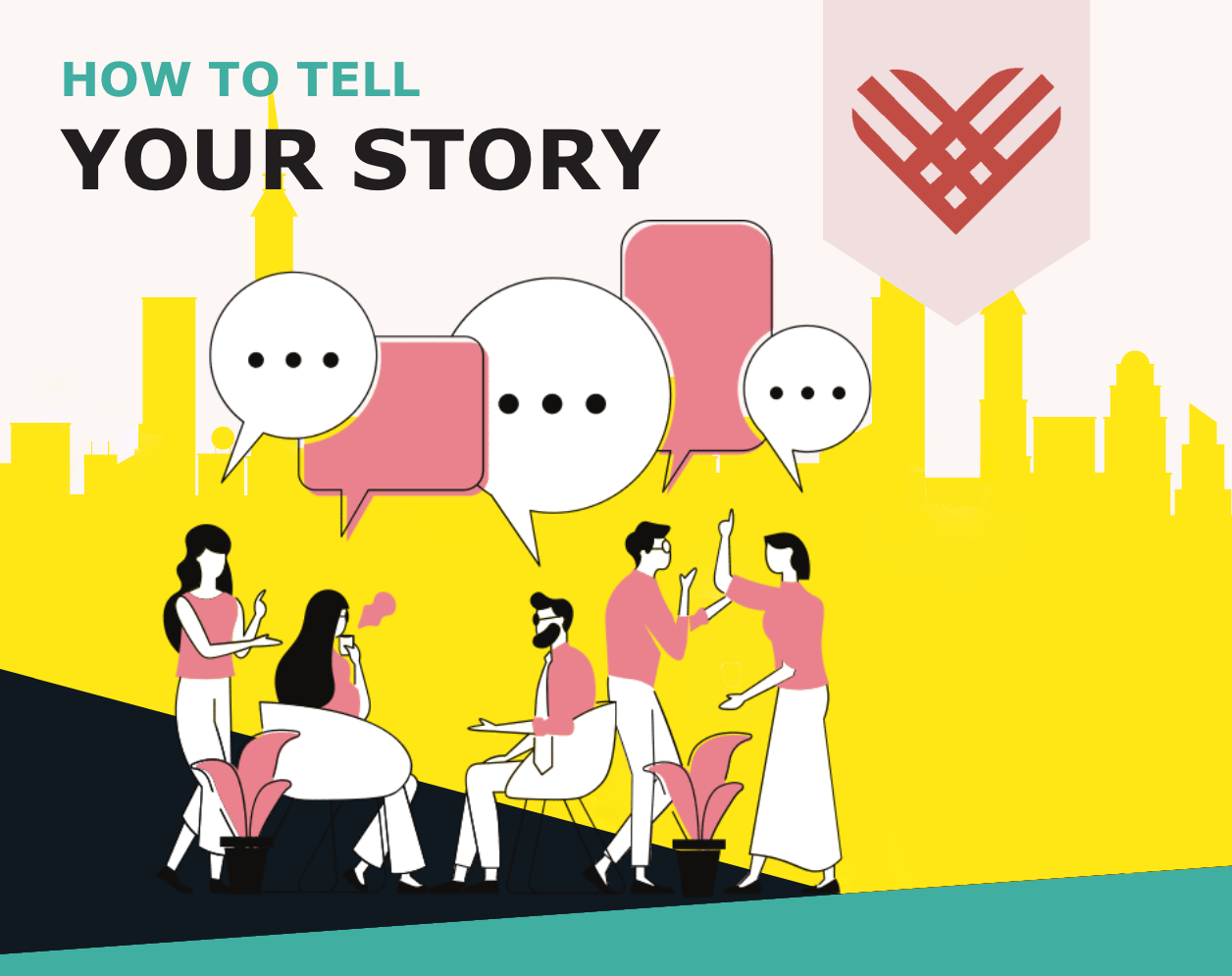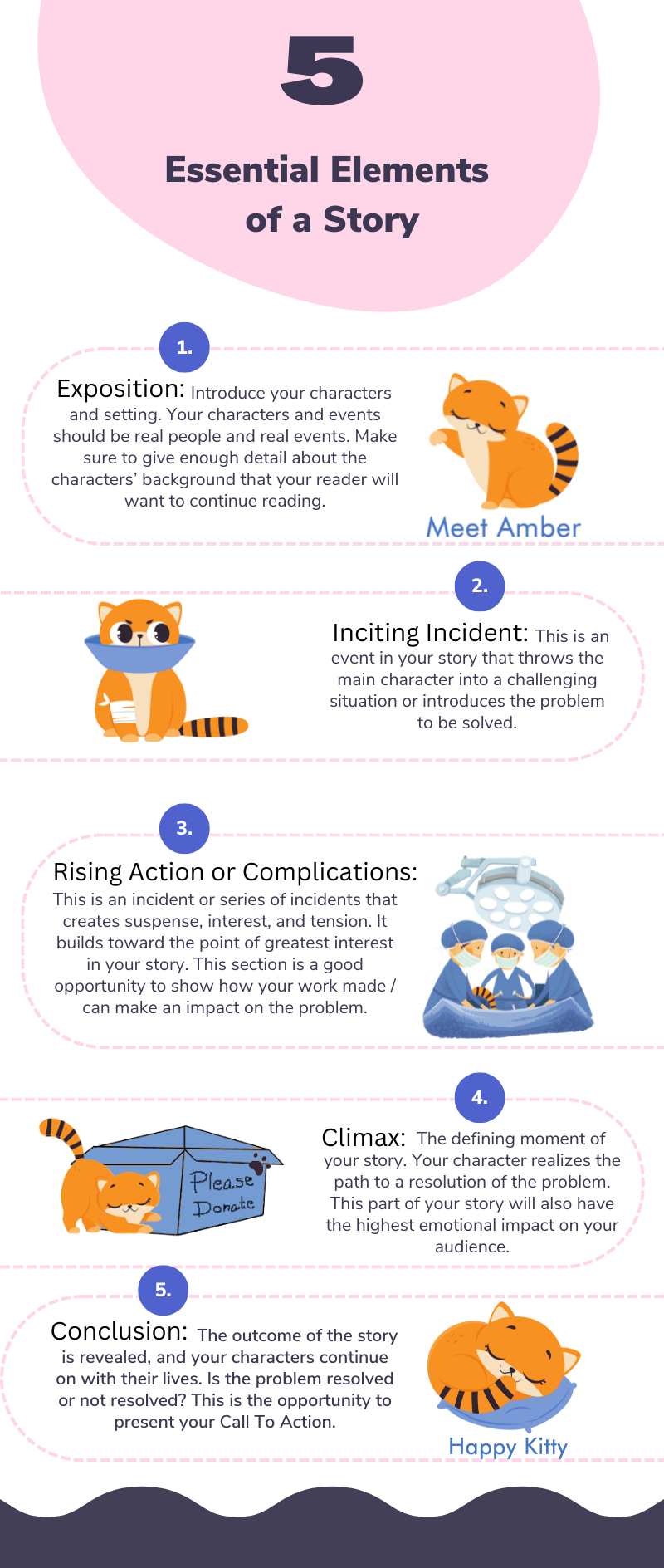GivingTuesday Series - How To Tell Your Story
October 4, 2022
 by Janet Bargewell, GiveDirect Support
by Janet Bargewell, GiveDirect Support
Promoting your organization's cause is challenging. There are a million nonprofits vying for attention and donor support. How do you win a donor's attention and stand out from the crowd?
If you've attended any marketing presentations recently, you will have heard one thing in all of them: The best way to engage donors is by telling your story. But how do you do that?
In this article, I'll introduce you to traditional storytelling techniques and give you a step-by-step process to create your story. These techniques apply to any appeal text you want to create — the script for a new video, a social media post, or the appeal text at the top of your GivingTuesday donation page.
Storytelling Is Your Most Important Marketing Tool
Storytelling has been around since the beginning of time. It used to be the only way to pass information from generation to generation; today, we have a myriad of other methods to transfer and/or receive information. But storytelling remains one of the most effective and popular ways to make a lasting impression.

Scholars have pointed out that facts and figures can be hard for the mind to grasp but listening to stories activates the areas of the brain associated with social and emotional processing.
Storytelling is an exceptional marketing tactic to tell your audience who you are, why your cause is important, and how it can help them or their community. You have probably talked about your mission in many ways, but storytelling (sharing real-life experiences) helps communicate your ideas and purpose in a way that creates an emotional connection. Storytelling can turn facts into lingering feelings for the donor while educating them about your cause and inspiring them to get involved.
How to Tell a Compelling Nonprofit Story
The difference between an anecdote and a story that moves your audience emotionally is planning for what you want the story to accomplish. You can do this by using storytelling techniques to make your point; to connect the dots between what you want your audience to know and what you want them to do. Before your start to write, you must first answer a few questions about your organization and your goals.
Who is my audience?
What is the problem or community need?
What is the solution?
What outcome would I like to see from someone reading this story?
What emotion do I want to elicit to achieve my outcome?
Once you have these answers, you can begin to develop your story.
Related article: Who is your social media audience?
Related article: What is your call to action?
GivingTuesday Story Topics
Here are some tried and true story topics for your GivingTuesday appeal.
Focus on one individual or family that you helped this year.
Talk about your biggest accomplishment from the past year.
Explain one project you're working on and why you need help with it.
Announce a major donor for a matching gift campaign.
Eliciting Emotion
In the nonprofit world, we often think about eliciting sympathy from a reader to engage with them. However, there are many other emotions that can act as a catalyst for action or to help you connect with your reader.
Try to think of ways that you could incorporate any of the emotions below into a story!
Amusement
Concern
Fear
FOMO (Fear Of Missing Out)
Hope
Joy
Sadness
Satisfaction
Shock / Outrage / Anger
Sympathy
The Five Essentials
Instead of thinking of your story having a beginning, a middle, and an end, use the model of the 5 essential story elements.
Exposition (introduce the characters)
Inciting Incident (introduce the problem)
Rising Action (complications)
Climax (a possible resolution to the problem)
Conclusion (the outcome)


Examples -- Putting It All Together
Now let's look at some examples to help you put it all together.
A Very Short Story
A story doesn't have to be long. In fact, it can consist of just a few sentences. Consider this example from Mt. Pleasant Animal Shelter.
"Amber was surrendered yesterday. Adopted only a few weeks ago, Amber underwent surgery this week for something no one could have predicted. Unfortunately, her surgical site became infected which required a second surgery to clean and repair the damage from the infection. Due to the mounting medical costs her family could no longer afford her care. Amber's journey is far from over. She is currently at the hospital, being monitored for a possible third surgery.
Caring for Amber will result in estimated medical costs of about $5,000. That is why donations to Nicky's Second Chance Fund are so important. Created years ago, this fund helps animals like Amber who deserve a second chance at life. Your gift gives us the ability to say yes to an animal in their greatest time of need. Any gift made to Nicky's Second Chance Fund will be life-saving."
Looking at the essential elements of a story, you can see that this story
- Introduces the character and the setting
- Introduces an inciting event
- Describes a complication
- Describes a path to the resolution of the problem
- Concludes with a call to action
Clara: EB Simplex
This is a story about a little girl with Epidermolysis Bullosa. The story starts out by introducing the main character, Clara, and sets the stage for us. Clara was born with this debilitating disease that has no treatment and no cure (at this time).
Excerpted
Clara was born in 2013 with severe generalized EB simplex...
Fast forward to present day. Our daughter is now 7 years old. She has severe generalized EB simplex due to a mutation of her Keratin 5 gene...Our Clara blisters everywhere, from head to toe, EB has affected her eyes, her esophagus, her teeth, her ability to move, and so much more. She requires two hours of wound care every day. She is followed by more specialists than I can count on one hand, and not one of them can offer us a proper treatment, because there is no treatment for EB.
Our daughter is a warrior. She gets up. She gets dressed. She goes to school. She plays. And she does this all with wounds scattered from head to toe... These activities she enjoys, they are so good for her soul, and so hard on her body. We have decided it is worth it, but it is a decision no parent should have to make.
In the early years it was the pain, the wound care, the appointments that were so hard. With each passing year, it is the emotional toll that has become the hardest...“Mommy, if all of this is because my one gene, why can’t someone just fix this”. Soul crushing to hear these words out of the mouth of your child, who is still too young to know all of the ways in which EB will make her life more challenging.
You would never know it from her joy and her smile, but I can say without exaggeration that EB affects every aspect of my daughter’s life. It honestly impacts most every aspect of our family’s life. It is our normal. But it is not normal. So we thank you from the bottom of our hearts for reading and learning and caring. For supporting such a cause. For helping the EB community come one small step closer to a treatment… To a cure for a disease that just seven short years ago we had no idea even existed.
This story contains excellent examples of the Inciting Incident, Rising Action and Climax. For Clara, this is her battle to carry on a normal life of a little girl, her efforts to deal with the nuances of her EB and her struggle to understand all the "whys" of this disease and the effects on her life.
The Conclusion is Clara's triumph in keeping her joy through it all and accepting her new normal.
Read the full story on the EB website.
Aging at home with Habitat's help
This story begins with a strong introduction to Walter, his life (past and present) and his family.
Excerpted
The first time Walter took a shower in his new bathroom, he cried. That’s because it was the first time the 81-year-old had a bathroom to shower in.
Walter talks about the volunteers and staff of Southern Crescent Habitat for Humanity who transformed one of his rooms into a bathroom so he no longer had to use an outhouse. The project was part of Habitat’s focus on repairs and renovations that can help people stay in their homes as they age. “I never had people be so nice to me,” Walter says. “You couldn’t meet people any better.”...
Walter raised eight children of his own in the house. He had a city job as a street sweeper but still couldn’t swing a bathroom. “It was rough,” he says. “And it was embarrassing.” But he takes pride that his kids were always clean. “We had washtubs, and we heated the water. You got to take a bath.”...
Walter’s daughter, Francine, has dropped by and is listening in as her father talks about her childhood. “Back then, there was just lots of love and no complaints,” she says....
“People rallied around Mr. Walter’s story and the history at the house, which means a lot emotionally and collectively to the family,” says Cynthia Jenkins, Southern Crescent Habitat‘s CEO. “It just made it even sweeter that we were able to help this truly humble, sweet, kind man who really worked hard, took care of his family and did not want to be a bother to anyone.
“A lot of us asked ourselves, ‘If we don’t help Mr. Walter, who then do we help?’”...
The bathroom itself has a good-size shower with grab bars and a shower seat. Photos of classic cars that Walter likes hang on the walls.
“All of those years, I never got used to not having a bathroom,” Walter says. “Now, I am so proud. And man, do I feel just great.”
The Inciting Incident is Walter's lack of an indoor bathroom and the Rising Action his aging and wanting to maintain his independence. This is the part of the story where Habitat is introduced to offer a solution to the problem. Pay particular attention to the effective use of quotes from Walter, his daughter, and the CEO of Southern Crescent's Habitat for Humanity to increase the story's emotional impact.
The Conclusion is the resolution of the problem: Walter gets a new bathroom.
Read the full story on the Habitat of Humanity website.
Also notice the additional information at the bottom of the page about Habitat's "Aging In Place" program and their subtle call to action.